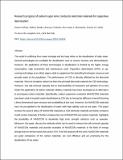| dc.description.abstract | The world is suffering from water shortage and the hope relies on the desalination of salty water. Several technologies are available for desalination such as reverse osmosis and electrodialysis. However, the application of these technologies in desalination is limited by the higher energy consumption, high investment and maintenance costs. Capacitive deionization (CDI), an up-coming technology at an infant stage is able to supplement the dwindling freshwater resources and provide water to the population. The performance of CDI is directly affected by the electrode materials. Since its inception carbon has been the principal electrode materials for CDI technology. However, low salt removal capacity due to inaccessibility of nanopores and ejection of co-ions hinder the application of carbon materials. Battery materials have been developed as an alternative to accompany carbon materials. Specifically, sodium superionic conductor (NASICON) materials have been used in brackish water desalination by CDI due to having the diffusion channels forming a three dimensional open structure and availability at low cost. However, the NASICON materials have not yet applied in the desalination of water with high salinity such as sea water. This paper reviews the present status of NASICON materials as CDI electrode materials and fairly compares it with carbon materials. It further compares the cost of NASICON and carbon materials, highlights the possibility of NASICON to desalinate high ionic strength solutions such as seawater. Moreover, the paper, discuss the methods which can be used to enhance the salt removal capacity of NASICON materials and provide examples of NASICON materials in the field of energy storage that can be borrowed and used in CDI. From the analysis of this work, NASICON materials are great companion of the carbon materials, are cost effective and are promising for the desalination of sea water. | en_US |

